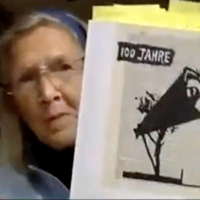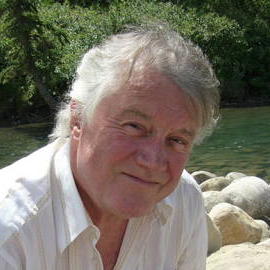- Iraq
- Haendel
- correspondence
- Dilbar Abdurahmonova
- Masetto
- Jean Pullois
- Rachel Valler
- Music and the Visual World
 VIDEO PODCAST: Discussion about Bernard Haitink (1929-2021), Salzburg, Roger Doyle's Finnegans Wake Project, the English Symphony Orchestra, the Chopin Competition Warsaw, Los Angeles Opera and other subjects.
VIDEO PODCAST: Discussion about Bernard Haitink (1929-2021), Salzburg, Roger Doyle's Finnegans Wake Project, the English Symphony Orchestra, the Chopin Competition Warsaw, Los Angeles Opera and other subjects.
 SPONSORED: The Many Hats of Allan Rae - A Birthday Greeting, by Endre Anaru.
SPONSORED: The Many Hats of Allan Rae - A Birthday Greeting, by Endre Anaru.
All sponsored features >>

A Very Individualistic Style
GEOFF PEARCE is inspired and amazed by the orchestral music of Grażyna Bacewicz
'... a fine recording ...'
I discovered Grażyna Bacewicz in my youth when I was introduced to her music by the Polish Embassy in New Zealand, something I am grateful for, as otherwise, like so many people, I would not know of her colourful and innovative music. Her oeuvre is quite large and varied, and she was well known over her lifetime as both a violinist and a composer.
This second volume of Bacewicz's orchestral music begins with the second symphony, written 1950-51. This four movement work is one of her better known works, and the first movement, Con passione, is colourful and skillfully orchestrated. A few different sections make up this movement, so there is much contrast.
Listen — Grażyna Bacewicz: Con passione (Symphony No 2)
(CHSA 5345 track 1, 3:38-4:29) ℗ 2025 Chandos Records Ltd :
The second movement, Lento tranquillo, is a respite from the nervous energy of the first movement and the business of the third movement. It is reflective and quite glorious.
Listen — Grażyna Bacewicz: Lento tranquillo (Symphony No 2)
(CHSA 5345 track 2, 2:22-3:03) ℗ 2025 Chandos Records Ltd :
The third movement, a scherzo, is the briefest of movements, and is vivacious and dancelike. Its whirlwind of energy takes the listener along with it.
The final movement starts in a quiet, almost subdued manner, although one can sense the tension and excitement behind it, and this is revealed quite quickly. This short movement, under five minutes in length, is quite varied in mood and energy. The work ends energetically.
Listen — Grażyna Bacewicz: Allegro moderato (Symphony No 2)
(CHSA 5345 track 4, 3:52-4:32) ℗ 2025 Chandos Records Ltd :
The Piano Concerto (1949) was, like all the pieces on this disc, dedicated to Polish conductor Witold Rowicki. It was composed for the Frederic Chopin Composers' Competition, and received second prize: no first prize was awarded. Grażyna Bacewicz is not one for long, drawn out works, as she is economical with her material and says what she wants to without any fuss or padding. This work is no exception. The soloist is the most excellent Peter Donohoe. The booklet gives an interesting insight into Poland's political and artistic climate when this work was written.
The opening movement, like the symphony preceding it on the disc, is varied in mood and tempo. There is something almost Bartókian about this piece. It certainly requires considerable technique and response to the ever changing landscape, and this the soloist delivers with his usual flair.
Listen — Grażyna Bacewicz: Allegro moderato (Piano Concerto)
(CHSA 5345 track 5, 0:52-1:36) ℗ 2025 Chandos Records Ltd :
The slow movement begins quite beautifully, and there is a rather mysterious yet wistful nature to this, with some rather dramatic crescendos that subside as quickly as they appear. The person who wrote the programme notes said that she found the movement somewhat like Szymanowski, and I have to agree with her - the harmonies did not always go in the direction that one thought they might.
Listen — Grażyna Bacewicz: Andante (Piano Concerto)
(CHSA 5345 track 6, 5:16-5:56) ℗ 2025 Chandos Records Ltd :
The last movement starts rather ominously, but is full of surprises, quick mood changes and some really deft orchestration. The piano part is not without its challenges either, and Peter Donohoe revels in this piece. I am surprised by the variety in this movement, considering the brevity, but this is often a characteristic of this composer, as I said before. I am surprised that this work is not performed more often, as it is refreshing and interesting.
Listen — Grażyna Bacewicz: Molto allegro (Piano Concerto)
(CHSA 5345 track 7, 4:27-5:20) ℗ 2025 Chandos Records Ltd :
The final work is the four movement Concerto for Large Symphony Orchestra (1962). I had not heard this work before. It is regarded as the start of Bacewicz's third and final period, and it is quite a departure from the style evident in the two previous works. The music is much more textual and less melodic in the traditional sense.
The first movement is terse, full of drama and colour, and over the course of five minutes, exhibits many changes. The orchestration is often filled with scale-like passages or short staccato utterances and is very striking. She also uses interesting contrasts of rests in between busy sections, and one always feels on edge.
Listen — Grażyna Bacewicz: Allegro (Concerto for Large Symphony Orchestra)
(CHSA 5345 track 8, 4:01-4:44) ℗ 2025 Chandos Records Ltd :
The second movement, very different from the first, is quite abstract and atmospheric. Here Bacewicz makes a lot of use of tuned percussion. She writes in a very individualistic style that is captivating and almost hypnotic.
Listen — Grażyna Bacewicz: Largo (Concerto for Large Symphony Orchestra)
(CHSA 5345 track 9, 4:44-5:34) ℗ 2025 Chandos Records Ltd :
The uniqueness of the preceding movement is mirrored in the next. There is pent up energy and great flurries of passages and a rather frenetic bongo drum part. I don't think I have ever heard anything quite like this movement, which is less than five minutes in length. At times I find it jocular, and at other times thoughtful.
Listen — Grażyna Bacewicz: Largo (Concerto for Large Symphony Orchestra)
(CHSA 5345 track 10, 3:46-4:21) ℗ 2025 Chandos Records Ltd :
The final movement is, as the programme notes suggest, quite Lutosławski-like, and is abstract and almost experimental in character, yet there is an underlying sense to it that is undeniable and exciting.
Grażyna Bacewicz is a composer who never ceases to inspire and amaze me. This is a fine recording of a great orchestra and soloist with excellent programme notes in the booklet and I sincerely hope that it will inspire newcomers to the music of this great Polish composer to explore further.
Copyright © 30 May 2025
Geoff Pearce,
Sydney, Australia



